Guest post from Margaret Hicks and Tara Dong of Pacific Assistance Dogs
Behaviour Adjustment Training it may be, but Brilliant+Awesome+Tremendous is what I want to answer whenever a new puppy-raiser asks what BAT stands for.
PADS (Pacific Assistance Dogs Society) raises and trains highly skilled Assistance Dogs for those with physical disabilities or who are deaf/hard-of-hearing. In addition, we train Canine Assisted Intervention (CAI) Dogs for placement in intervention settings with community professionals such as RCMP, counselors, therapists and teachers. It goes without saying that our dogs—who will eventually accompany their partners everywhere they go—must be confident, and well in control of their behaviour and emotions.
Some think that assistance dogs are a “super breed” that never bark, bounce or really even breathe… the reality is a success rate of roughly 50% (industry wide). This means 50% of our dogs are too “enthusiastic”, or too fearful, or too calm/passive, or have health issues) to be successful as working dogs.
As a member of Assistance Dogs International, our staff and trainers are exposed to some of the best knowledge and trainers in the industry. Collaboration is rich and the sharing of knowledge and experience is abundant. So it was the most fortuitous discovery when one day, our training manager stumbled upon BAT on YouTube while searching for something that demonstrated a technique she’d seen at a recent conference. Her reaction was instant: “This is BRILLIANT!”
As a result, when our school offered to host the 2013 ADI trainers conference, it was a natural fit to invite Grisha Stewart. She arranged for Joey Iversen to conduct a workshop for conference attendees as well as our own volunteers. It took our initial excitement and firmly grounded it into our program.
Now, we’ve integrated BAT into our volunteer puppy-raising program. These volunteers range from stay-at-home moms and retirees to singles living in downtown skyscrapers — they raise our young pups for roughly 14-16 months, attending weekly puppy classes, socializing and teaching them foundational skills.
While BAT is an amazing tool to empower reactive dogs that have existing issues, we have integrated as a foundational skill for our program. We have the privilege many do not in that we have our pups from birth, so are able to use BAT as a foundational tool to allow our volunteers to be successful and empower our dogs to build trust in their handler and confidence in their environment as they grow.
To illustrate the evolution that has taken place we introduce you to 3 of our dogs, pre-BAT “Ruby”, BAT-1.0 “Merlot” and our latest BAT 2.0 pup “Seven”.
Ruby | 2007
A sweet black lab named Ruby entered our program about 8 years ago (pre BAT). She was a push button dog, you showed her, she learned it. You asked for it she did it. Her willingness and smarts were rockstar material. She was biddable and silly, intelligent and willing. But what we couldn’t seem to give her was confidence. She crumbled under the pressures of public places, stress-forging on leash, losing control of her bladder when startled by strangers and shutting down and digging in her heels when we’d attempt to help her overcome fear with lures and rewards. Belugas to bearded men, waterfalls to car alarms, Ruby was a worrier. Her fears didn’t start out big, at first they were just a sideways look. But looking back knowing what I know now, I wonder who she would have become if those initial sideways looks had been given the time and space to build confidence. At nine months she was released from the program for generalized suspicion. A heartbreaking decision, she was a dog with so much ability and who was otherwise so well suited for a working career.
Merlot | 2013
Fast forward a few years, and Merlot, another black lab arrives. She’s an enthusiastic girl with a natural off switch, equally happy laying at your feet for hours on end or outrunning every dog at the park. In public she pads along, shuffling her feet like an old soul. She accompanies her raisers everywhere—whether it’s the mall, fireworks, concerts and sporting events. Like Ruby, she encounters things that cause her to pause, but her raisers are now familiar with BAT and see the subtle changes in her body language in new environments — a hesitation — her ears flattening slightly or and her “old man shuffle” turning into a bouncy prance. One such outing was to the PNE, an exhibition in Vancouver, BC with lots of large farm animals, crowds, a midway and strange sights and smells. There in the barns she met “Big Bob” a 3500lb bull. As she approached he stormed up to the edge of his pen snorting at her in protest. Merlot hit the opposite end of her leash, tail tucked, visibly shaken.
It was time for BAT. This was a girl at her most fearful. She was shut down, tail tucked, feet firmly planted, eyes fixed on “Big Bob” and unwilling to take her eyes away even for food. Her handler moved towards her gently and waited for any indication she was calming. Within a few moments she dropped her ears and turned her head. They moved away. She took in the environment. Approached. Retreated. Within 10 minutes Merlot was nose to nose with Bob. It all happened in the quiet and calm…
As the months went on, there would often be things that would give Merlot reason to pause. A statue, a piece of heavy equipment, even a particularly high frequency hair dryer at a salon … each time the BAT sessions would get shorter. Today she’s a self-assured two-year old that moderates her own worries and concerns with ease and rarely needs assistance to do so.
Seven | 2014
This spunky little yellow Labrador, from our “Star Trek” litter is named for the character Seven of Nine (though rumour has it that it’s also because she channels the energy of 7 puppies in one tiny body). Very early Seven showed us that what she lacked in size, she made up for in spunk. Even at 4 weeks old she was smart and feisty and took great pleasure in using her sibling’s tails as tug toys and zooming with glee. A leash was a force to be reckoned with and her off switch was non-existent. Seven is naturally a high arousal (lunging/barking) pup, particularly around other dogs and cats…or food or leaves or people or anything that was exciting to her in the moment. She would wake at 7:30 in the morning and often not close her eyes for more than a minute or two until 10pm at night.
And then BAT began to “happen”. Nothing prepared us for the remarkable power it would have in this young girl. We began using BAT with her off and on at roughly 6 weeks old (when she was still in the whelping home and obsessing over the resident cat). But in her first two weeks of puppy-raising she’s gone from a roughly 25′ threshold around other animals to being calm, cool and collected within 2 feet of stimuli at just 10 weeks old. This remarkable transformation in her self- regulation seems to have extended into all aspects of her training.
Why does this matter so much?
Our Volunteers | High-energy/arousal dogs are exhausting, challenging puppies, so providing volunteer raisers with positive, effective solutions and tools is essential. Clicker training will reward desirable behaviour, but more often than not our raisers would say “This puppy gives me nothing to click” – BAT resolved that. Even when there was opportunity to click, the timing was challenging for a lot of new raisers. BAT gives the dogs (and their people) the tools they need to shine and to experience success at a very young age; simple, easy to understand and use tools. This creates calm not just in the puppy, but their handler as well.
Our clients / We walk a tightrope in breeding dogs, we want dogs with a good off switch but enough drive that they want to work. More often than not we get dogs that are so much drive that they can’t shut off or so soft that they are fearful or lack persistence and working drive. BAT helps both. It increases our margins of success. With a 2-3 year wait list that recently had to be closed to application, every dog matters. Increasing our success rates by even one dog a year means that one less client is waiting for life-changing independence.
We are in absolute awe of the work that Grisha’s done and so grateful to both her and Joey for their willingness to share knowledge and empowering not only our organization, but our dogs like Seven and Merlot to move more confidently towards those that are patiently waiting for the day they’ll receive their leashes.

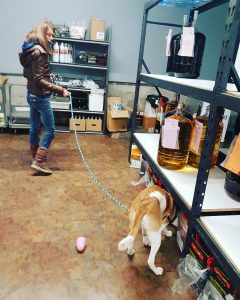
 By law, service animals must be under control when working. That means we have to figure out ways to reestablish training, and ‘empowered partnership’ means we do it in a way that also meets the dogs’ emotional needs.
By law, service animals must be under control when working. That means we have to figure out ways to reestablish training, and ‘empowered partnership’ means we do it in a way that also meets the dogs’ emotional needs.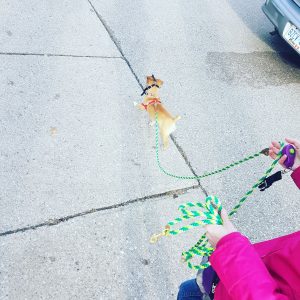 I go through the handler’s stance by gliding my hands over their shoulders (with permission). I go over their arms, their wrists and hands. I tell them what their body is showing, their energy, and what I see with their body language. Dogs responds to this.
I go through the handler’s stance by gliding my hands over their shoulders (with permission). I go over their arms, their wrists and hands. I tell them what their body is showing, their energy, and what I see with their body language. Dogs responds to this. My questions are, ‘Are you in the moment?‘ and ‘Can you look at how you holding the leash?’ I slide my hands gently down the leash and pull a tad (this is where you are creating tension). I remind them, ‘Remember to be in the moment with your partner.’
My questions are, ‘Are you in the moment?‘ and ‘Can you look at how you holding the leash?’ I slide my hands gently down the leash and pull a tad (this is where you are creating tension). I remind them, ‘Remember to be in the moment with your partner.’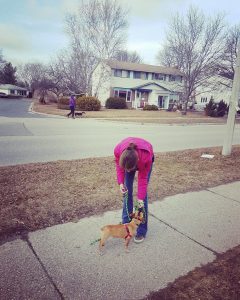 [Grisha’s note – touching the client can be distracting or it can be really useful. Please use your best judgement when working with clients and always get their consent, verbally and by observing their body language! Just as with the dogs, we need to respect their boundaries.]
[Grisha’s note – touching the client can be distracting or it can be really useful. Please use your best judgement when working with clients and always get their consent, verbally and by observing their body language! Just as with the dogs, we need to respect their boundaries.] Usually the handlers are almost paranoid, edgy and worried about judgement when we start; trying to correct their dog every move they make.
Usually the handlers are almost paranoid, edgy and worried about judgement when we start; trying to correct their dog every move they make.
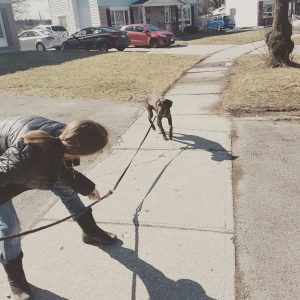 It takes no time for them to figure out and we have communicated clearly what we would like.
It takes no time for them to figure out and we have communicated clearly what we would like.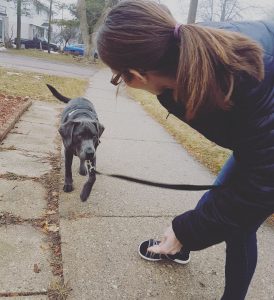 No fighting, no pulling back and no frustration.
No fighting, no pulling back and no frustration. Even though some don’t have fearful or aggressive issues, the BAT leash protocols work excellent for unwanted behaviors and habits that have formed.
Even though some don’t have fearful or aggressive issues, the BAT leash protocols work excellent for unwanted behaviors and habits that have formed. We need to give respect and empathy to these amazing working dogs. BAT is one great way to help these dogs, whether it’s maintenance BAT leash protocols or BAT aggressive and fearful adjustment training.
We need to give respect and empathy to these amazing working dogs. BAT is one great way to help these dogs, whether it’s maintenance BAT leash protocols or BAT aggressive and fearful adjustment training.



